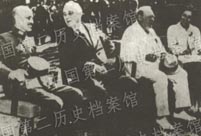 YOG kicks off in Nanjing
YOG kicks off in Nanjing
 Colorful life at Youth Olympic Village of Nanjing 2014 YOG
Colorful life at Youth Olympic Village of Nanjing 2014 YOG
 Royal Taoist temple to open to public
Royal Taoist temple to open to public
 Female soldiers at quake-hit area
Female soldiers at quake-hit area
 Shocking photos of cruel battles in Ukraine
Shocking photos of cruel battles in Ukraine
 Amphibious armored vehicle unit conducts open sea drill
Amphibious armored vehicle unit conducts open sea drill
 Water relay in Henan
Water relay in Henan
 Ethnic culture feasts eyes of travelers
Ethnic culture feasts eyes of travelers
 80 security dogs assembled in Nanjing police dog training base
80 security dogs assembled in Nanjing police dog training base
 Graffiti artists paint on street walls in Xinjiang
Graffiti artists paint on street walls in Xinjiang
WELLINGTON, Aug. 25 -- New Zealand scientists said Monday they could be closer to a cure for diabetes after identifying a hormone that causes the disease.
The discovery by an international research team meant scientists knew the trigger mechanism that causes beta-cells of the pancreas, which make insulin, to die in both type-1 and type-2 diabetes, study leader Professor Garth Cooper, of Auckland University's School of Biological Sciences, said in a statement.
The research showed "compelling evidence" that type-1, or juvenile onset, diabetes and type-2 diabetes were both caused by the formation of tiny toxic clumps of amylin, a hormone produced by the same cells in the pancreas that produce insulin.
The small clumps of amylin in turn destroyed the cells that produced insulin and amylin, resulting in diabetes, where sugar levels in the blood rise, causing damage to organs such as the heart, kidneys, eyes and nerves.
"We are confident this discovery can be used to make new classes of anti-diabetic medicines and hope to have potential medicines ready for entry into clinical trials within the next two years," Cooper said.
"We aim to treat patients with both forms of the disease with the objective being to stop the death of the insulin-producing cells and the longer-term goal of increasing these cells."
According to the International Diabetes Federation, the number of people contracting diabetes worldwide is expected to reach 592 million by 2035.
But the causal mechanisms for both types of diabetes have remained obscure, making it very difficult to design effective medicines for its prevention or cure.
The two common forms of diabetes are type-1, also known as juvenile onset diabetes in which insulin is vital to ensure survival, and type-2, the more common form which is an increasing global health problem.after identifying a hormone that causes the disease.
The discovery by an international research team meant scientists knew the trigger mechanism that causes beta-cells of the pancreas, which make insulin, to die in both type-1 and type-2 diabetes, study leader Professor Garth Cooper, of Auckland University's School of Biological Sciences, said in a statement.
The research showed "compelling evidence" that type-1, or juvenile onset, diabetes and type-2 diabetes were both caused by the formation of tiny toxic clumps of amylin, a hormone produced by the same cells in the pancreas that produce insulin.
The small clumps of amylin in turn destroyed the cells that produced insulin and amylin, resulting in diabetes, where sugar levels in the blood rise, causing damage to organs such as the heart, kidneys, eyes and nerves.
"We are confident this discovery can be used to make new classes of anti-diabetic medicines and hope to have potential medicines ready for entry into clinical trials within the next two years," Cooper said.
"We aim to treat patients with both forms of the disease with the objective being to stop the death of the insulin-producing cells and the longer-term goal of increasing these cells."
According to the International Diabetes Federation, the number of people contracting diabetes worldwide is expected to reach 592 million by 2035.
But the causal mechanisms for both types of diabetes have remained obscure, making it very difficult to design effective medicines for its prevention or cure.
The two common forms of diabetes are type-1, also known as juvenile onset diabetes in which insulin is vital to ensure survival, and type-2, the more common form which is an increasing global health problem.
 Eye-catching guides at the opening ceremony of YOG in Nanjing
Eye-catching guides at the opening ceremony of YOG in Nanjing A female missile launch company of PLA
A female missile launch company of PLA China, the U.S., Britain and the Soviet Union call for Japan's unconditional surrender
China, the U.S., Britain and the Soviet Union call for Japan's unconditional surrender Beautiful night scenery of Nanjing
Beautiful night scenery of Nanjing Passenger transport starts on Tibet's new railway
Passenger transport starts on Tibet's new railway Story of outstanding Beijing swat sniper
Story of outstanding Beijing swat sniper Beautiful policewoman in an anti-terrorism SWAT team
Beautiful policewoman in an anti-terrorism SWAT team Cute photos of little Taoist nuns and monks go viral online
Cute photos of little Taoist nuns and monks go viral online Photo story: How a baby panda grows up
Photo story: How a baby panda grows up Star-leveled nursing home in a small county
Star-leveled nursing home in a small county Evidence of monstrous crime of Japanese invaders
Evidence of monstrous crime of Japanese invaders Foreign models compete with Chinese in Cheongsam show
Foreign models compete with Chinese in Cheongsam show The beautiful pictures of ancient Chinese architecture
The beautiful pictures of ancient Chinese architecture The Muslims involved in relief work
The Muslims involved in relief workDay|Week|Month